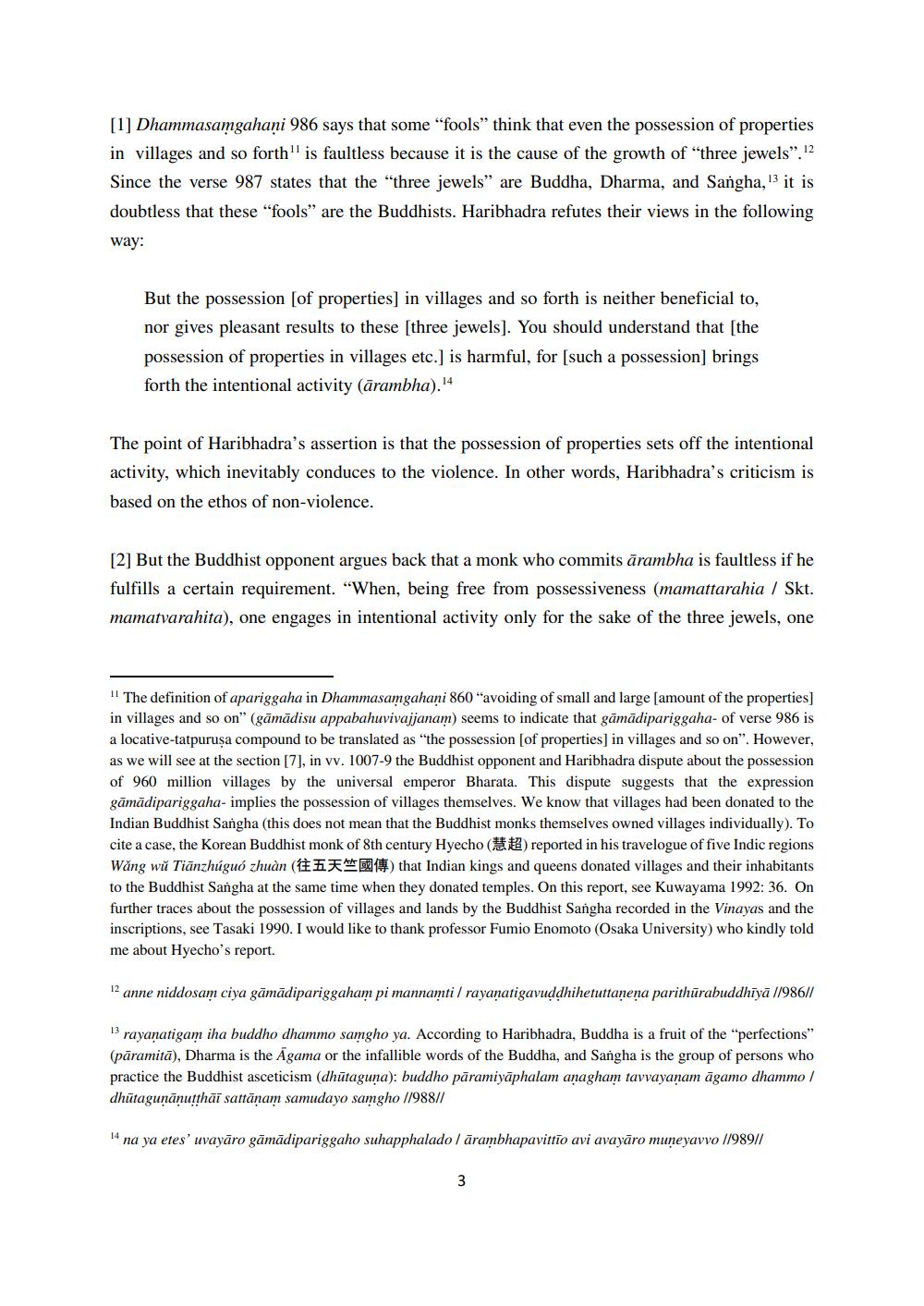Book Title: Haribhadra On Property Ownership Of Buddhist Monk Author(s): Yutaka Kawasaki Publisher: Yutaka Kawasaki View full book textPage 3
________________ [1] Dhammasamgahani 986 says that some "fools" think that even the possession of properties in villages and so forth" is faultless because it is the cause of the growth of three jewels". 12 Since the verse 987 states that the three jewels" are Buddha, Dharma, and Sangha, '3 it is doubtless that these "fools" are the Buddhists. Haribhadra refutes their views in the following way: But the possession [of properties) in villages and so forth is neither beneficial to, nor gives pleasant results to these [three jewels). You should understand that the possession of properties in villages etc.) is harmful, for such a possession] brings forth the intentional activity (ārambha).14 The point of Haribhadra's assertion is that the possession of properties sets off the intentional activity, which inevitably conduces to the violence. In other words, Haribhadra's criticism is based on the ethos of non-violence. [2] But the Buddhist opponent argues back that a monk who commits ārambha is faultless if he fulfills a certain requirement. “When, being free from possessiveness (mamattarahia / Skt. mamatvarahita), one engages in intentional activity only for the sake of the three jewels, one " The definition of apariggaha in Dhammasamgahani 860 "avoiding of small and large [amount of the properties] in villages and so on" (gāmādisu appabahuvivajjanam) seems to indicate that gāmādipariggaha- of verse 986 is a locative-tatpurusa compound to be translated as the possession [of properties) in villages and so on". However, as we will see at the section [7], in vv. 1007-9 the Buddhist opponent and Haribhadra dispute about the possession of 960 million villages by the universal emperor Bharata. This dispute suggests that the expression gāmādipariggaha- implies the possession of villages themselves. We know that villages had been donated to the Indian Buddhist Sangha (this does not mean that the Buddhist monks themselves owned villages individually). To cite a case, the Korean Buddhist monk of 8th century Hyecho ( 2) reported in his travelogue of five Indic regions Wăng wă Tiānzhúguo zhuan ( ¥) that Indian kings and queens donated villages and their inhabitants to the Buddhist Sangha at the same time when they donated temples. On this report, see Kuwayama 1992: 36. On further traces about the possession of villages and lands by the Buddhist Sangha recorded in the Vinayas and the inscriptions, see Tasaki 1990. I would like to thank professor Fumio Enomoto (Osaka University) who kindly told me about Hyecho's report. 12 anne niddosam ciya gāmādipariggaham pi mannamti / rayanatigavuddhihetuttanena parithūrabuddhīyā //986// 13 rayanatigam iha buddho dhammo samgho ya. According to Haribhadra, Buddha is a fruit of the "perfections" (pāramitā), Dharma is the Agama or the infallible words of the Buddha, and Sangha is the group of persons who practice the Buddhist asceticism (dhūtaguna): buddho pāramiyāphalam anagham tavvayanam agamo dhammo / dhūtagunānutthāi sattānam samudayo samgho //988// 14 na ya etes' uvayāro gāmādipariggaho suhapphaladolārambhapavittio avi avayāro muneyavvo //989//Page Navigation
1 2 3 4 5 6 7 8 9 10 11 12
